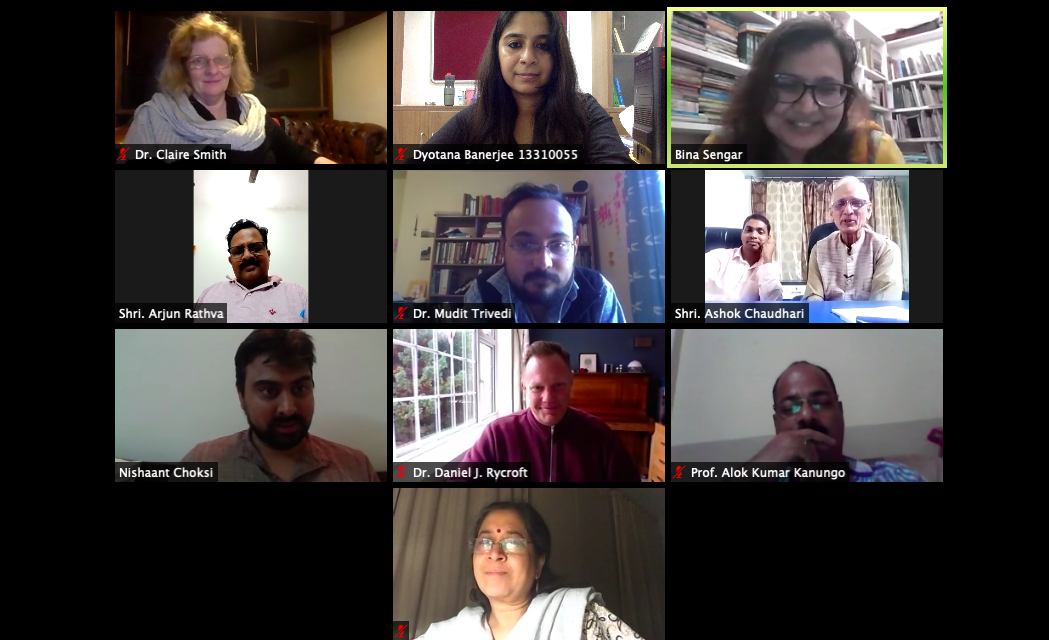Ahead of Mahatma Gandhi’s 151st birth anniversary, IITGN and Flinders University, Australia jointly organised a one-day international webinar on ‘Gandhi and the Adivasi Question’, on October 01, 2020. The webinar aimed to understand the legacy of Gandhi and Gandhian for understanding Adivasi communities, politics, and identity today. This was part of SPARC (Ministry of Education, Government of India) initiative.
Many Gandhian experts, scholars and Adivasi activists participated in the webinar to discuss Gandhian political philosophy, the history of Gandhian movements post-independence, contemporary struggles for Adivasi rights, Gandhi’s legacy in relation to Adivasis, and how his ideas have impacted the present day Adivasi social movements.
The interdisciplinary panel discussion on ‘Gandhi and the Adivasi Question’ brought forth various topics. In his talk titled ‘Gandhi and the Category of Adivasis: Understanding Extra Parliamentary Vocabulary’, Dr Dhananjay Rai from the Central University of Gujarat discussed Gandhi’s various constructive programs, the omission of Adivasi issues in the initial constructive programs and its inclusion in the later ones (after 1945). He said, “The inclusion of Adivasi issues in the constructive program brought the question of collective rights and territorial rights into the discourse. The constructive program gave an ‘extra-parliamentary’ vocabulary to the Adivasi question that has various repercussions for future Adivasi politics in India.”
Dr Bina Sengar from Babasaheb Ambedkar Marathwada University, Aurangabad, talked about ‘Historicising Political Discourse of Gandhians and Adivasi Communities in Western India.’ She argued that Gandhi was the first leader in the Indian political system who integrated the rural masses in the independence struggle. Still, Gandhi had very little interaction with the Adivasi communities. It was mainly the Gandhians like Jugatram Dave and Thakkar Bapa who mostly interacted with Adivasis. Gandhians didn’t adequately engage with the history and cultural life of the Adivasi communities, they built the ashrams, leading to Sanskritisation of the ashram system.
Talking about ‘Perceptions of Gandhi among Tana Bhagats of Eastern India’, Dr Sangeeta Dasgupta from Jawaharlal Nehru University, discussed how a section of the Oraon tribal community in Jharkhand known as ‘Tana Bhagat’ reveres Gandhi as a deity in the community. Adding further, she said, “This was due to the participation of the Tana Bhagat in the nationalist movement, it was believed that Gandhi was a spiritual entity who inspired the Tana Bhagats to sacrifice land to fight the British. In this case, Gandhi takes on the same features as other famous tribal leaders, such as Birsa Munda, as he is interpreted in the local context.”
The fourth speaker of the panel discussion, Mr Arjun Rathva from MC Rathva College, Pavi Jetpur, Gujarat, discussed ‘Hind Swaraj from a contemporary Adivasi perspective’. Talking about the concept of ‘Hind Swaraj’, he said, “In ‘Hind Swaraj’, Gandhi has clearly stated what kind of India he is expecting after freedom. According to Gandhi, freedom for India was to be free from the very nature of colonialism. The concept of freedom that he talked about was very important for Adivasis. ‘Hind Swaraj’ reflected what Adivasis were fighting for a long time. But in modern India, Adivasis are facing an identity crisis and feel displaced from their culture.”

The keynote talk of the webinar was delivered by Dr Daniel J Rycroft, who is the Chairperson of India Dialogue at the University of East Anglia, UK. He specialises in South Asian art and anthropological history. He has worked and published extensively on representations of Adivasis in Indian art, and the colonial anthropological legacy on Adivasi politics and self-determination. In his talk titled ‘The Question of Human Dignity in Adivasi Studies’, Dr Daniel discussed the idea of ‘Adivasi citizenship’ within the field of human dignity laid out by the UN Sustainable Development Goals. He said that early anthropologists who dealt with Adivasis had identified certain aspects of Adivasi democracy which exists in their village systems and the equal distribution of power.
“The idea of ‘dignity’ also circulated in early pictures of Adivasi heroes such as Birsa Munda, which was recognised by Gandhi in the 1940 Congress conference in Ramgarh (Jharkhand). So Adivasi struggle and academic engagement with Adivasis helped shape Gandhi’s ideas, and this can be a contribution to the field of ‘Human dignity’ on an international stage with respect to global indigenous people’s movements”, he said.
Concluding his talk, Dr Daniel said, “We need to understand the permutations of human dignity because it affects our capacity to know and understand each other. We can explore how human dignity often sits in a productive triangulated relationship with both: human rights and human responsibility.”
The webinar concluded with a detailed discussion and conversation with Shri Ashok Chaudhari, a senior Gandhian leader and Adivasi activist from Adivasi Ekta Parishad and Dr Jitendra Vasava, President of the Adivasi Sahitya Academy, a forum to promote awareness on Adivasi culture and literature. Both of them gave several historical and intriguing perspectives on how, before Gandhi, there were a number of Adivasi social movements in western India, and the Maharaja of Baroda state extended education facilities to Adivasi areas to create an educated class of Adivasis. They expressed that Gandhi and Gandhians took a lot of inspiration from Adivasis, for instance, charkha and handspun cloth were already there in many Adivasi communities, the concept of Gram Swaraj was already practised in Adivasi communities. Shri Ashok Chaudhari was of the opinion that instead of following western models, we should incorporate Gandhi’s ideas into the development process of the country.
This news was covered by some of the leading Indian newspapers and media agencies. Click on the links below to read more.

